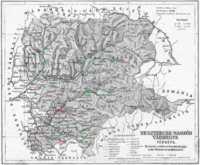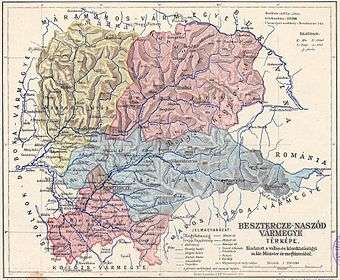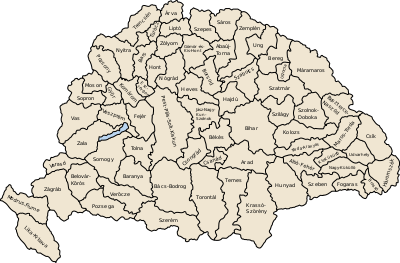Beszterce-Naszód County
Beszterce-Naszód was an administrative county (comitatus) of the Kingdom of Hungary. Its territory is now in northern Romania (north-eastern Transylvania). The capital of the county was Beszterce (now Bistrița).
| Beszterce-Naszód County | |
|---|---|
| County of the Kingdom of Hungary (1876-1920, 1940-1945) | |
 Coat of arms
| |
 | |
| Capital | Beszterce |
| Area | |
| • Coordinates | 47°8′N 24°30′E |
• 1910 | 4,333 km2 (1,673 sq mi) |
| Population | |
• 1910 | 127800 |
| History | |
• Established | 1876 |
• Treaty of Trianon | 4 June 1920 |
• County recreated (Second Vienna Award) | 30 August 1940 |
• Disestablished | 1945 |
| Today part of | |
| Bistrița is the current name of the capital. | |
Geography
Beszterce-Naszód county shared borders with the Kingdom of Romania, the Austrian Bukovina, and the Hungarian counties Máramaros, Szolnok-Doboka, Kolozs, Maros-Torda, and Csík. Its area was 4167 km² around 1910.
History
Beszterce-Naszód county was formed in 1876, when the Transylvanian Saxon district of Beszterce/Bistritz was united with the district of Naszód (1772–1851 Military Frontier district) and part of Doboka County. In 1920 the Treaty of Trianon assigned the territory of Beszterce-Naszód county to Romania. In 1940 by the Second Vienna Award it was returned to Hungary and were expanded with additional territories from the former Kolozs County. After World War II, it became again part of Romania, the territory of the county is now in the (larger) Romanian county Bistrița-Năsăud.
Demographics
In 1900, the county had a population of 119,014 people and was composed of the following linguistic communities:[1]
Total:
- Romanian: 82,256 (69,1%)
- German: 26,036 (21,9%)
- Hungarian: 8,475 (7,1%)
- Ruthenian: 165 (0,1%)
- Slovak: 128 (0,1%)
- Serbian: 4 (0,0%)
- Croatian: 9 (0,0%)
- Other or unknown: 1,941 (1,6%)
According to the census of 1900, the county was composed of the following religious communities:[2]
Total:
- Greek Catholic: 66,078 (55,5%)
- Lutheran: 22,874 (19,2%)
- Eastern Orthodox: 15,290 (12,9%)
- Jewish: 6,385 (5,4%)
- Roman Catholic: 4,927 (4,1%)
- Calvinist: 3,349 (2,8%)
- Unitarian: 101 (0,0%)
- Other or unknown: 10 (0,0%)

In 1910, county had a population of 127,843 people and was composed of the following linguistic communities:[3]
Total:
- Romanian: 87,564 (68,5%)
- German: 25,609 (20,0%)
- Hungarian: 10,737 (8,4%)
- Ruthenian: 213 (0,2%)
- Slovak: 37 (0,0%)
- Croatian: 11 (0,0%)
- Serbian: 6 (0,0%)
- Other or unknown: 3,666 (2,9%)
According to the census of 1910, the county was composed of the following religious communities:[4]
Total:
- Greek Catholic: 72,494 (56,7%)
- Lutheran: 22,415 (17,5%)
- Eastern Orthodox: 16,615 (13,0%)
- Jewish: 7,254 (5,7%)
- Roman Catholic: 5,083 (4,0%)
- Calvinist: 3,781 (3,0%)
- Unitarianist: 200 (0,1%)
- Other or unknown: 1 (0,0%)
Subdivisions

In the early 20th century, the subdivisions of the county Beszterce-Naszód were:
| Districts (járás) | |
|---|---|
| District | Capital |
| Besenyő | Beszterce, (Romanian: Bistrița) |
| Jád | Beszterce, (Romanian: Bistrița) |
| Naszód | Naszód, (Romanian: Năsăud) |
| Óradna | Óradna, (Romanian: Rodna) |
| Urban districts (rendezett tanácsú város) | |
| Beszterce, (Romanian: Bistrița) | |
See also
References
- "KlimoTheca :: Könyvtár". Kt.lib.pte.hu. Retrieved 2012-12-06.
- "KlimoTheca :: Könyvtár". Kt.lib.pte.hu. Retrieved 2012-12-06.
- "KlimoTheca :: Könyvtár". Kt.lib.pte.hu. Retrieved 2012-06-19.
- "KlimoTheca :: Könyvtár". Kt.lib.pte.hu. Retrieved 2012-06-19.
